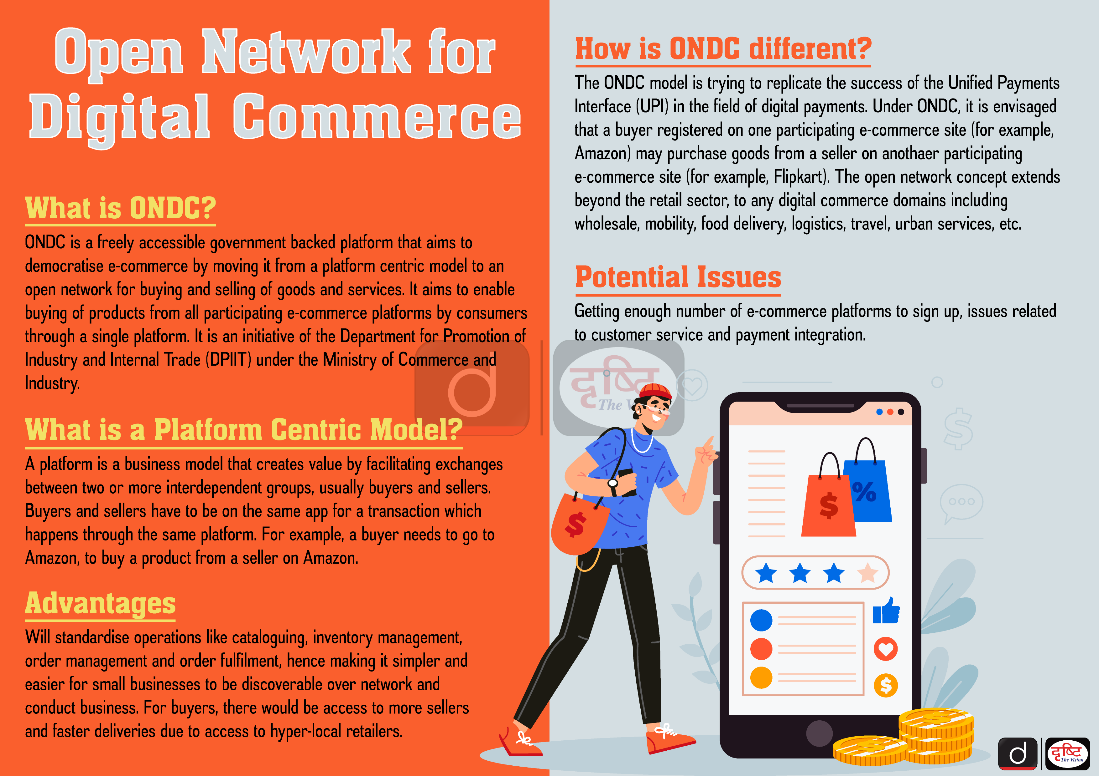Open Network for Digital Commerce | 25 Jun 2022
For Prelims: Open Network for Digital Commerce, UPI, Initiatives related to e-Commerce
For Mains: Significance of Open Network for Digital Commerce
Why in News?
Recently, the government has launched the pilot phase of Open Network for Digital Commerce (ONDC) with an aim to “democratise” the country’s fast growing digital e-commerce space that is currently dominated by the two U.S.-headquartered firms — Amazon and Walmart.
What is ONDC?
- About:
- ONDC is a freely accessible government-backed platform that aims to democratise e-commerce by moving it from a platform-centric model to an open network for buying and selling of goods and services.
- Under ONDC, it is envisaged that a buyer registered on one participating e-commerce site (for example, Amazon) may purchase goods from a seller on another participating e-commerce site (for example, Flipkart).
- Presently, buyers and sellers have to be on the same app for a transaction which happens through the same platform. For example, a buyer needs to go to Amazon, to buy a product from a seller on Amazon.
- It is a not-for-profit organisation that will offer a network to enable local digital commerce stores across industries to be discovered and engaged by any network-enabled applications.
- The open network concept extends beyond the retail sector, to any digital commerce domains including wholesale, mobility, food delivery, logistics, travel, urban services, etc.
- It is neither an aggregator application nor a hosting platform, and all existing digital commerce applications and platforms can voluntarily choose to adopt and be a part of the ONDC network.
- The ONDC aims at promoting open networks developed on open-sourced methodology, using open specifications and open network protocols, independent on any specific platform.
- Implementation of ONDC, which is expected to be on the lines of Unified Payments Interface (UPI) could bring various operational aspects put in place by e-commerce platforms to the same level.
- The project to integrate e-commerce platforms through a network based on open-source technology has been tasked to the Quality Council of India.
- Open source refers to a software program or platform with source code that is readily accessible and which can be modified or enhanced by anyone. Open source access grants users of an application permission to fix broken links, enhance the design, or improve the original code.
- ONDC is a freely accessible government-backed platform that aims to democratise e-commerce by moving it from a platform-centric model to an open network for buying and selling of goods and services.
- Benefits:
- The ONDC will standardise operations like cataloguing, inventory management, order management and order fulfilment, hence making it simpler and easier for small businesses to be discoverable over network and conduct business.
- Potential Issues:
- Experts have pointed out some likely potential issues such as getting enough number of e-commerce platforms to sign up, along with issues related to customer service and payment integration.
What is the Significance?
- On ONDC, buyers and sellers may transact irrespective of the fact that they are attached to one specific e-commerce portal.
- This could give a huge booster shot to smaller online retailers and new entrants.
- However, if mandated, this could be problematic for larger e-commerce companies, which have their own processes and technology deployed for these segments of operations.
- ONDC is expected to digitise the entire value chain, standardise operations, promote inclusion of suppliers, derive efficiency in logistics and enhance value for consumers.
- The platform envisages equal-opportunity participation and is expected to make e-commerce more inclusive and accessible for consumers as they can potentially discover any seller, product or service by using any compatible application/platform, thus increasing their freedom of choice.
- It will enable transactions of any denomination, thus making ONDC a truly ‘open network for democratic commerce’.
- Over the next five years, the ONDC expects to bring on board 90 crore users and 12 lakh sellers on the network, enabling 730 crore additional purchases.
UPSC Civil Services Examination, Previous Year Question (PYQ)
Q. With reference to ‘Quality Council of India (QCI)’, consider the following statements: (2017)
- QCI was set up jointly by the Government of India and the Indian Industry.
- Chairman of QCI is appointed by the Prime Minister on the recommendations of the industry to the Government.
Which of the above statements is/are correct?
(a) 1 only
(b) 2 only
(c) Both 1 and 2
(d) Neither 1 nor 2
Ans (c)
Exp:
- The Quality Council of India was set up jointly by the Government of India and the Indian Industry represented by the three premier industry associations, i.e., Associated Chambers of Commerce and Industry of India, Confederation of Indian Industry and Federation of Indian Chambers of Commerce and Industry. Hence, statement 1 is correct.
- It was set up to establish and operate national accreditation structure and promote quality through National Quality Campaign.
- The Council plays a pivotal role at the national level in propagating, adoption and adherence to quality standards in all important spheres of activities including education, health care, environment protection, governance, social sectors, infrastructure sector and such other areas of organized activities that have significant bearing on improving the quality of life and wellbeing of the citizens of India.
- The Department for Promotion of Industry and Internal Trade (Ministry of Commerce and Industry), is the nodal ministry for QCI.
- It is governed by a Council of 38 members with equal representations of government, industry and consumers.
- Chairman of QCI is appointed by the Prime Minister on the recommendation of the industry to the government. Hence, statement 2 is correct.
- Therefore, option (c) is the correct answer.


